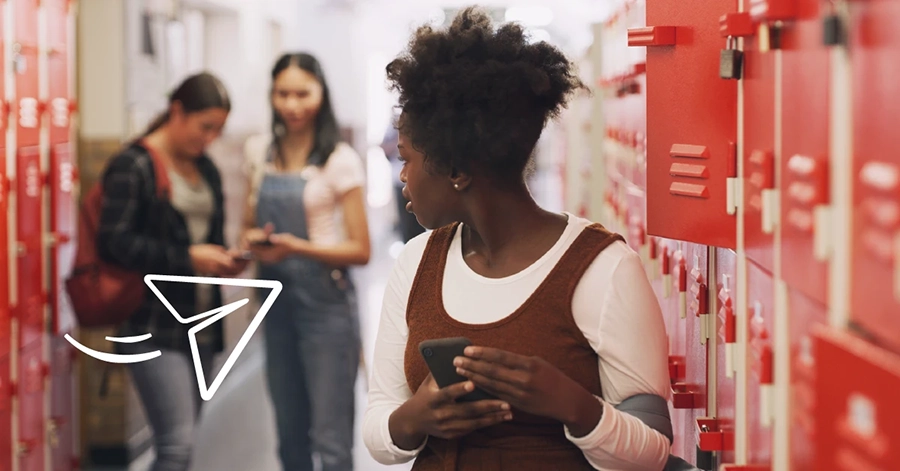
High school cliques are nothing new to kids nowadays. Most likely, we all have experiences with either being in or out of the “popular group”. And if not, we’ve all seen countless high school movies about cliques and the drama that comes with them.
Navigating high school cliques — and friendships at this age, in general — can be difficult for any kid. That’s why it’s important for parents to teach their kids healthy and lasting social skills that will help them make smart decisions when it comes to cliques in school.
But we know that can be equally difficult for parents, so that’s why we put together this quick and helpful guide to teach parents what they need to know about cliques and what they can teach their kids about them. We’ll go over how to talk to your kid about them, as well as topics like facing rejection and building confidence in your teen.
What Are Cliques?
Before we discuss how to talk to your child about high school cliques, it’s probably a good idea to go over what a clique actually is.
Cliques in schools are social circles of people who share similar interests or characteristics that set them apart from other students. In general, that’s just a normal friend group and it’s nothing to worry about. However, a friend group can become a clique when it starts to become exclusionary. When the members of the group don’t let anyone else join and they show rude behavior towards outsiders.
Factors such as age, gender, race, ethnicity, and socioeconomic status can all contribute to the formation of cliques in high schools. It can be helpful for parents to consider how these factors might impact their kids as they begin to form relationships with peers in high school.
Step 1: Spot The Clique From Your Bird’s Eye View
As a parent, you get to have somewhat of an outside perspective — or bird’s eye view — when it comes to your kid’s friend group. Your child may not be able to recognize signs of a clique (such as exclusionary behavior or manipulation from a group member) but chances are, you could spot it first. The older your kids get, the more you become an observer of their social life rather than an active participant. Use that to your advantage!
Once you recognize a clique, don’t pull the eject button for your kid just yet. First, start an open dialogue with your kid and simply ask them questions about what you’ve observed. This will help you get a better understanding as well as make your child feel safe to talk about their experiences.
Step 2: Find Your Listening Cap
As your child starts to navigate their friendships more independently, it becomes all the more important that home is still their safe place to process the things going on in their life. For parents, that means putting on your listening cap and putting away your problem-solving hat. Allow them to freely talk with no judgment or criticism, that way they’ll feel more comfortable sharing any worries or concerns they have.
In terms of problem-solving, try not to give them a step-by-step solution but encourage them to consider some solutions on their own. As parents, this can be the hardest thing in the world because we’ve spent their whole lives fixing their problems! But now is the time to let them explore their own ideas and support them, no matter what happens.
Step 3: Share Your Stories
Never underestimate the power of examples! Parents, you’ve lived a lot longer than your kids which means you have years of experience navigating cliques, friends, and just people in general. So don’t be afraid to share! Whether it’s stories from your childhood or even recent stories from work, your kids can learn a lot from how you talk about those experiences. And they don’t all have to be “do as I did” lessons. Sometimes the more impactful stories are the “don’t do as I did!”
For cliques specifically, share any stories you have where you had to go against the grain or whatever was popular at the time. Share how you approached it, how you came out of it, and maybe what you would’ve done differently. Not only can kids learn from your experience, but it can also show them that they’re not alone in what they’re going through.
These honest conversations will be a big part of creating a safe environment for your kid to open up about their thoughts and feelings. Additionally, it will help teach your kids strong interpersonal relationship skills, which they’ll need well beyond high school!
Step 4: Teach Them The Practicals
Now for some practicality. While listening and sharing your personal experiences are important, there’s going to be a time when they need some actionable advice. Of course, the advice you give is dependent on the situation, but there are a few tools you can put in their toolbelt that will likely be helpful in most clique situations.
Active listening
One fact about humans is that we aren’t always good at saying what we actually mean. Active listening is simply taking what a person says and figuring out what they actually mean. This is difficult for everyone — adults included — but the teenage years are a great time to start building that skill. This will help them to first have empathy for their friends or peers and then patiently try to get to the bottom of the problem.
Self-advocacy
Here’s another skill that even adults have a hard time with — self-advocacy and knowing when to walk away. Sometimes, cliques can become unhealthy to the point where your child may be faced with standing up for themselves at the risk of losing some friends. Maybe your child is feeling peer pressured or even bullied by a certain clique in school. In that case, there’s no better time to teach your kid that they are worthy and deserving of good friends, and sometimes to find those friends you have to walk away from the clique. While this is a difficult thing to navigate as a kid (not to mention a difficult thing to watch as their parent), it can have lasting effects on your child having respect for themselves and for their relationships.
Keeping healthy boundaries
Teaching your child to set healthy boundaries is key to helping them navigate high school cliques. Encourage them to be honest about their feelings, wants, and needs in any situation. And if needed, remind them that it’s always okay to say ‘no’ when they feel uncomfortable. This is where those skills of active listening and problem solving can be super helpful if they have to have tough conversations with peers or teachers.
Positive role models
Giving your children positive role models can help shape their outlook on relationships and social interactions in high school. If they have mature older siblings, cousins, or friends, they can be great examples to point your kids in the right direction. Especially if you’ve seen them be inclusive, kind, and compassionate — those are awesome qualities to point out and encourage.
Facing rejection
It’s natural for everyone at some point, especially in high school, to experience rejection from time to time. This is part of growing up! While there’s not much you can do to avoid it, there are a lot of great ways to teach through it and help your child grow as a result. First, you’ll want to build up their confidence again and remind them they are awesome no matter what anyone says! And they don’t need a certain friend or clique to be validated.
Then, offer some constructive advice to help your child move on in a healthy way from the rejection. Providing resources, such as books or articles, that discuss issues related specifically to navigating cliques could help open up meaningful dialogue.
Step 5: Remind Them What’s Really Cool
It’s only natural to want to fit in with your peers, but it’s important to remember that being “in” isn't necessary for a great high school experience. The key is understanding what makes you unique and celebrating those qualities rather than trying to change yourself to conform.
One way of doing this is by encouraging your kids to find activities and interests outside of school or cliques that make them happy. This could include anything from joining a club to getting involved in the community to starting up hobbies like photography, painting, or writing — the possibilities are endless! The important part is that they know that doing what you enjoy is what’s really cool, not fitting in with the popular clique at school.
Step 6: Monitor With Bark
There’s a lot to teach kids as they enter their high school years. And all of it is important — self-respect, healthy boundaries, active listening, and facing rejection are all super valuable lessons. But that doesn’t mean they have to learn it all at once! As their parent, you’ll know how best to guide them in all of these things when the time comes.
Do you need help navigating the world of high school cliques now that your child is transitioning into high school? Bark can help you monitor what your kids are doing online through text messages and protect them from bullies and other online predators. You can even get advice from expert psychologists using our Bark products. Start your free trial today!
Read more
Bark helps families manage and protect their children’s digital lives.





